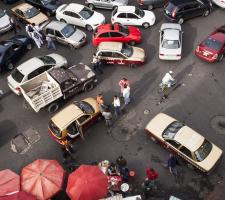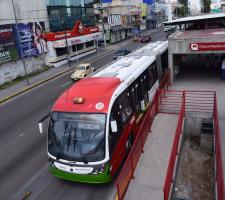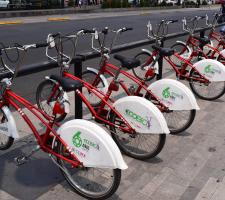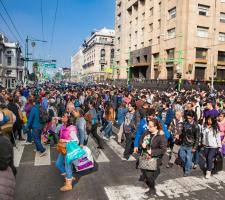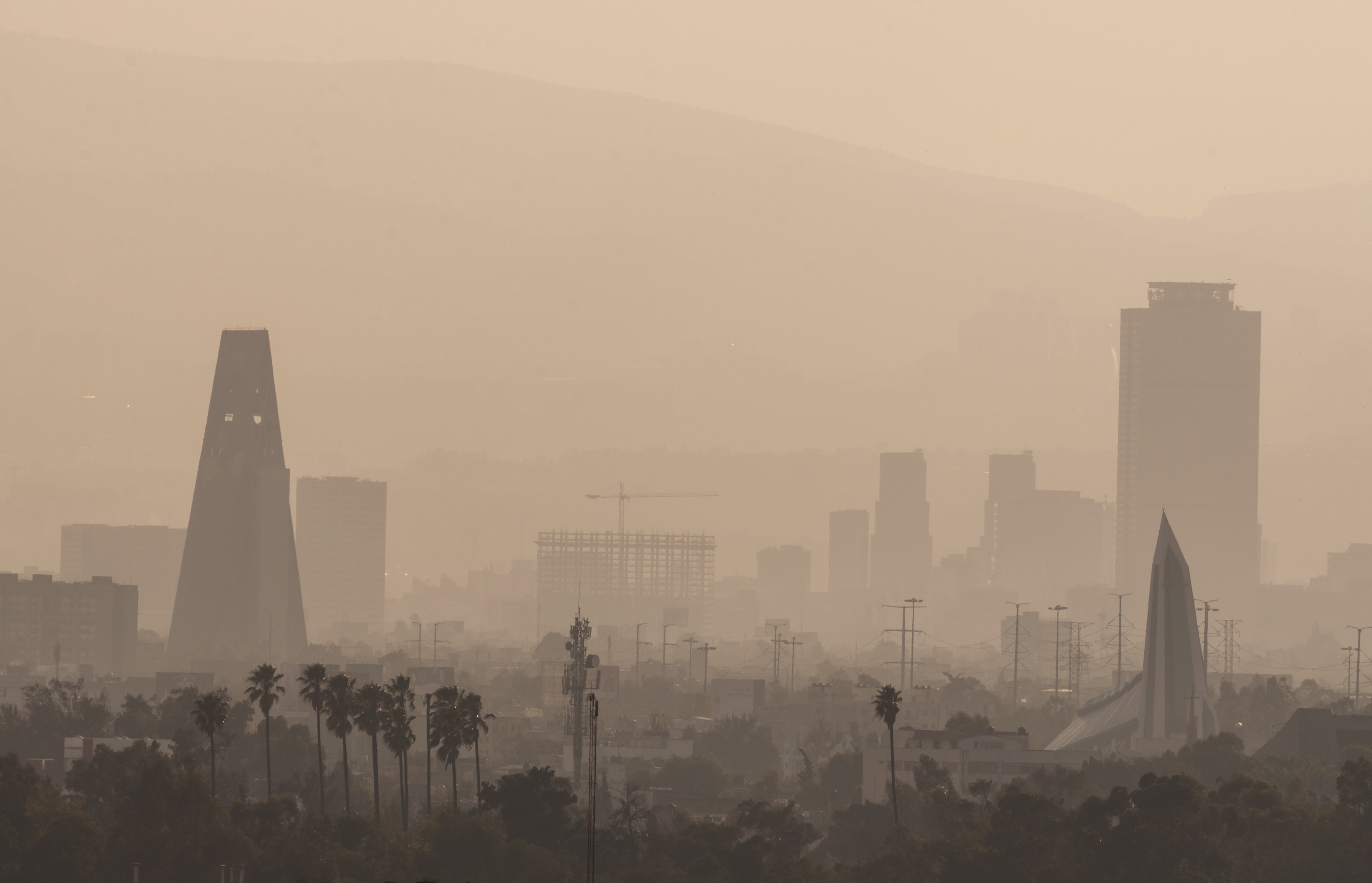
In 1992, the United Nations named Mexico City as the world’s most polluted urban centre. In the first half of 2016, following the updating of pollution alert limits to meet international standards, Mexico recorded 115 days where ozone concentrations exceeded the acute exposure health limit.
Pollution reached levels not experienced in the previous decade because of adverse climatic conditions - including thermal inversions which inhibit pollutants from naturally rising and dispersing. Conditions on 16 of these days exceeded the of cial pollution alert level, leading to number plate-based restrictions on car movements.
Such measures did, as in the past, bear fruit, ITS México president José Azcárate told ITS International. But there are inherent problems resulting from inadequacies in the city’s vehicle ownership registry and the network of engine checking stations that inhibit the effective monitoring of an estimated 3.5 million cars. In the short term Azcárate sees little prospect of the widescale introduction of technology-driven improvements.
The 2016 events occurred during the recent series of ProAire anti-pollution programmes, a joint initiative run by the Mexican government and the city, which started in 1990. These have achieved worthwhile results - for example, a 7.7 million tonne reduction in carbon emissions from all sources over the period 2008-2012, against a target of 7 million tonnes.
This latest phase, which runs until 2020, includes measures for the greening of the municipal transport eets but comes against a continuing backdrop of dense and heavily congested stop-go traffic.
The problem is one of geography. The Zona Metropolitana del Valle de México, which incorporates the national capital and neighbouring municipalities, lies 2,200m above sea level, a height that makes for the less-than-ideal combustion of fossil fuels. Mexico City also sits in a natural basin, virtually surrounded by mountains which trap the polluted air, so cutting the number of and emissions from road vehicles remains a crucial target.
In the meantime, fleets of inefficient trucks and cars continue to consume dirty diesel fuels and emit high levels of black carbon (a classified carcinogen and a powerful contributor to climate change) and particulate matter. These effusions are poisoning the environment and people’s health.
New initiatives
Recently the Geneva-based
It also urges a combination of on-board vehicle diagnostic systems and dynamic tailpipe exhaust tests, as the basis for a mandatory regime for restricting access by unsatisfactory vehicles. Monitoring would initially be manual, at inspection stations, and progressively move to remote on-road sensing. Mexico City has already carried out research into remote sensing with a view to securing more widespread and reliable results. It is also the subject of a current worldwide surge of interest, which is making international experience readily available.
However, the city’s environmental department has faced challenges (on constitutional grounds) to such a regime being made mandatory, and the ITF has offered the results of its own research as supporting evidence. Azcárate told ITS International: “Any technology that could support compliance needs to rest on two basic elements: legal certainty and defined standards for vehicles to meet. Unfortunately, neither is currently present in its entirety.”
The ITF also recommended an early start on preparatory work for a low emission zone (initially for freight vehicles) and the extension of the 80km/h limit on urban motorways and ring roads within Mexico City, and more widely across the metropolitan area. It wants to encourage driving at more constant speeds, which ‘produces immediate reductions in emissions at very little cost’ and offers the most effective measure available to lower tiers of governments for achieving these. The ITF sees this as the best option that “does not affect personal mobility negatively”.
Mexico City previously rejected average speed detection on the grounds that this does not pick up peaks of sustained velocity, which Azcárate sees as a central issue for dealing with congestion. The ITF also urges the extension of the Ecoparq meter network, introduced in 2012 to rationalise largely free-for-all unregulated parking, across the metropolis. It also wants to see parking charges differentiated to reflect pressures on spaces in individual areas of the city and incentivise modal shift where public transport and cycling facilities are good (see box).
Better buses
In the public transport sector, the ITF is encouraging the expansion of the existing Metrobús bus rapid transit (BRT) network. Launched in 2005 on a busy 20km corridor route as part of ProAire III, this is now the longest such network in Latin America, offering good connections with the city’s metro system.
Its introduction gave a badly needed boost to the capital’s previously poor image for road-based public transit. It achieved what ‘Restructuring public transport through Bus Rapid Transit’, a global reference work published in 2016, called ‘transformative momentum’, by enabling owners of more than 900 out-of-date ‘microbuses’ to become partners in new operating concessions.
‘Officials understood that the whole industry was watching, and that operators’ experience in the maiden BRT corridors would reverberate in future negotiations’, the citation continued and said it served to establish the role of the public sector in bus service regulation.
During its first six years, the initial BRT line was able to reduce CO2 equivalent emissions by 300,000 tonnes, a rate that rose to over 100,000 tonnes a year with subsequent expansions.
BRT has taken pressure off metro lines and other bus services and subsequently achieved a degree of integration with the city’s cycle path network. But success has brought its own problems, with high ridership levels contributing to overcrowding and increased risk of missed connections with other services - a clear case, says Azcárate, for the introduction of ITS technology.
He doubts, however, whether the support systems needed for tracking operation, reviewing service frequencies, monitoring average speed in specific time slots and calculating passenger densities per hour and per stop are being fully used or maintained.
A miracle waiting to happen
Some of the ITF’s findings echo an earlier intervention by the California, US-based Mario Molina Center for Energy and the Environment, which was founded and is directed by Mario Molina, the Mexican-born Nobel Prize-winning professor. It claims its Milagro (Megacity Initiative: Local Global and Research Observations) programme as the first international effort to study the impact of a megacity on air quality and climate, with the Mexican capital as the chosen case study.
The organisation urged the integration of the
In terms of private vehicle use, it pushed not only for the promotion of clean technologies, but also for fuel pricing that would take account of external costs. In the freight sector, it proposed achieving reductions in emissions by updating the country’s existing standards for heavy-duty vehicles to meet US
This process is now under way. The International Council on Clean Transportation, which has offices in three continents, has carried out a cost-benefit analysis for the period 2018-2037. It estimates a net gain across Mexico of US$123bn, including the value of avoided early deaths and reduced impacts on the climate.
These generate large numbers of lengthy trips, which are typically made in old and highly-polluting cars and microbuses. At the same time, suburban rail services tend to be underused, because of the lack of strategies for encouraging US-style transit-oriented development.
The ITF is therefore looking forward to the implementation of the New Mobility Law for Mexico City, announced in 2014, which laid the foundations for a new regulatory body for mass transit corridors and transport operators. It also introduced the concept of mobility impact assessments, to be implemented cooperatively by the city’s housing and mobility departments.
Meanwhile ProAire continues, in conjunction with federal, state and air quality agencies in the metropolitan area. Azcárate finds it “praiseworthy that, despite the lack of a legal framework and of reliable vehicle records, and the daily movements of some 22 million people, the city’s air quality indices are being maintained at acceptable levels.” But there is widespread agreement that any long-term solution will depend on filling the data and administrative gaps, and deploying technology. There is likely to be a short-term pause during the national and Mexico City governments’ 2018 election year, as the new administrations bed in.
‘Restructuring public transport through Bus Rapid Transit’ is published by Policy Press www.press.uchicago.edu (ISBN 978 1 44732 616 8).


